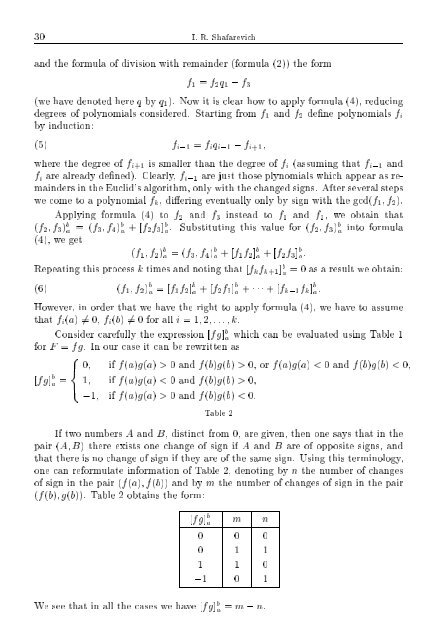SELECTED CHAPTERS FROM ALGEBRA I. R. Shafarevich Preface
SELECTED CHAPTERS FROM ALGEBRA I. R. Shafarevich Preface
SELECTED CHAPTERS FROM ALGEBRA I. R. Shafarevich Preface
You also want an ePaper? Increase the reach of your titles
YUMPU automatically turns print PDFs into web optimized ePapers that Google loves.
30 I. R. <strong>Shafarevich</strong>and the formula of division with remainder (formula (2)) the formf 1 = f 2 q 1 ; f 3(we have denoted here q by q 1 ). Now itisclearhow to apply formula (4), reducingdegrees of polynomials considered. Starting from f 1 and f 2 dene polynomials f iby induction:(5) f i;1 = f i q i;1 ; f i+1 where the degree of f i+1 is smaller than the degree of f i (assuming that f i;1 andf i are already dened). Clearly, f i;1 are just those plynomials which appear as remaindersin the Euclid's algorithm, only with the changed signs. After several stepswe come to a polynomial f k ,dieringeventually only by sign with the gcd(f 1 f 2 ).Applying formula (4) to f 2 and f 3 instead to f 1 and f 2 , we obtain that(f 2 f 3 ) b a = (f 3f 4 ) b a +[f 2f 3 ] b a . Substituting this value for (f 2f 3 ) b a into formula(4), we get(f 1 f 2 ) b a =(f 3 f 4 ) b a +[f 1 f 2 ] b a +[f 2 f 3 ] b a:Repeating this process k times and noting that [f k f k+1 ] b a = 0 as a result we obtain:(6) (f 1 f 2 ) b a =[f 1f 2 ] b a +[f 2f 3 ] b a + +[f k;1f k ] b a :However, in order that we have the right to apply formula (4), we have to assumethat f i (a) 6= 0,f i (b) 6= 0 for all i =1 2 ...k.Consider carefully the expression [fg] b a which canbeevaluated using Table 1for F = fg. In our case it can be rewritten as8>< 0 if f(a)g(a) > 0andf(b)g(b) > 0, or f(a)g(a) < 0andf(b)g(b) < 0,[fg] b a = 1 if f(a)g(a) < 0andf(b)g(b) > 0,>:;1 if f(a)g(a) > 0andf(b)g(b) < 0.Table 2If two numbers A and B, distinct from 0, are given, then one says that in thepair (A B) there exists one change of sign if A and B are of opposite signs, andthat there is no change of sign if they are of the same sign. Using this terminology,one can reformulate information of Table 2, denoting by n the number of changesof sign in the pair (f(a)f(b)) and by m the number of changes of sign in the pair(f(b)g(b)). Table 2 obtains the form:[fg] b a m n0 0 00 1 11 1 0;1 0 1We see that in all the cases we have [fg] b a = m ; n.
















